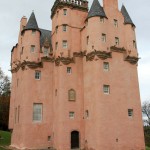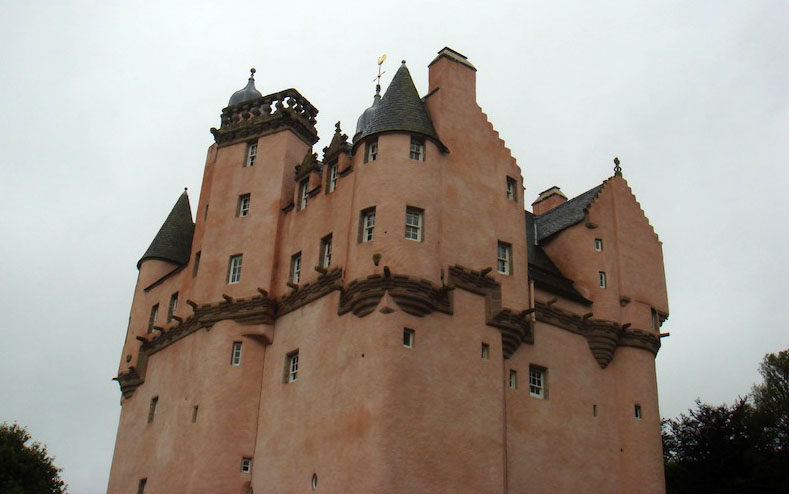If nothing else, my first visit to Scotland in years confirmed that the weather can never be relied upon. One day we were hot and bothered in the sun on top of a mountain, the next waking to drenching rain.
At least we had Craigievar to visit during the couple of days we were spending in the royal village of Ballater. As we drove off, rain thrashed our hire car, the wind howled through the glens and clouds collapsed over the hills. Talk about miserable…
Umbrellas in hand, we stopped en route for a quick look at the white-painted and romantically named Cambus o’May suspension bridge, a pretty pedestrian affair over the handsome River Dee that we’d spotted a few days earlier on our drive to the Cairngorms from Aberdeen. There were ghosts there, of the old railway that ran through these parts once upon a time. Indeed, the bridge had been built to help people reach the nearby station.

Back on the road, the verdant countryside was hidden by mist. The cattle we spotted in a field near the castle, huddled together under a tree for shelter, looked as pissed off as I felt.
But even in the most miserable of summer weather, Craigievar turned out to be a beautiful place. Spectacular scenery, lush woodlands and hills helped to frame this fine example of Scottish Baronial architecture.
Following several years of restoration by the National Trust for Scotland, Craigievar was looking as good as new. Delicately pink walls helped it to stand out amid the greenery but it was a lot smaller than I thought it was going to be from the pictures. It squatted in the heart of its estate, a big fat tower with four plain-ish walls until the upper section, which was embellished with turrets, cupolas and corbelling.

Powerful merchant William Forbes had ordered its completion in the early 1620s, after buying it when work had stalled under the original owners.
We couldn’t walk around it on our own. To protect the building and its contents, the National Trust’s guide took us on a tour, telling the story of its construction, describing the people who lived there and recounting the myths.
It was a charming place, on a much more homely scale than many castles. It was easy to picture members of the Forbes-Sempill family relaxing around the dining table and crawling into a warm bed while the snow fell outside. They lived on the estate for 350 years until the 1960s when the building, which even then had electricity in only a few rooms, was handed over to the trust. It still has little in the way of utilities to light the way and heat the rooms.

The grand hall was the focus of the building back then and remains so today, the place where the lord dispensed justice and met his visitors. Up the winding stone stairs, the bedrooms and other family rooms were much smaller, with oppressively low but fine plasterwork ceilings.
Centuries-old furniture remained where it had always stood along with more modern items and mementos from the family’s past, portraits of the Forbes family through the centuries.
The castle was a treat but it was disappointing that the rain meant we couldn’t really explore the grounds on one of the footpaths through the estate.
Outside or in, the word ‘romantic’ was invented for a place like Craigievar…

